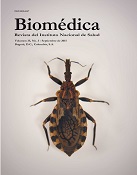Prevalence and intensity of infection by soil-transmitted helminths and prevalence of malaria among schoolchildren in El Salvador
Abstract
Introduction: El Salvador does not have recent data on the prevalence of infection with soil-transmitted helminths among children aged under 15 years of age. As one of the countries in the Americas that reports few malaria cases, eradication of this disease from El Salvador is considered to be feasible.
Objective: To determine the prevalence and intensity of infection by soil-transmitted helminths, as well as the prevalence of Plasmodium spp. in schoolchildren aged 8-10.
Materials and methods: A cross-sectional study was carried out in each of the five eco-epidemiological zones of the country (coastal plain, central basin, volcanic range, coastal range and mountain zone). In all 1,325 students we studied the presence of geohelminthiasis, with 152 of them also being tested for malaria. The Kato–Katz technique was used to detect geohelminths while diagnosis of malaria was performed using the rapid diagnostic test, microscopy and polymerase chain reaction.
Results: The overall prevalence of geohelminthiasis was 7.9% (95%CI 6.6-9.5%). Values for the five eco-epidemiological zones were as follows: coastal plain, 14.9% (95%CI 10.9-19.7%); central plateau, 9.4% (95%CI 6.5-13.3%); volcanic range, 6.6% (95%CI 4.2-10.5%); coastal range, 5.9% (95%CI 3.8-9.4%), and mountain zone, 2.6% (95%CI 1.4-5.7%). The overall rate of high intensity infection with any of the geohelminth species was 0.3%. No schoolchildren were found infected with Plasmodium spp. by any of the three diagnostic techniques used.
Conclusion: Prevalence of geohelminths was low and Trichuris trichiura was the predominant species. Intensity of infection with any of the species of geohelminths was light (<1%). The risk factors associated with infection by soil-transmitted helminths were defecation in the open air, being barefoot and living in coastal areas.
Downloads
Some similar items:
- Iveth J. González, Metacaspases and their role in the life cycle of human protozoan parasites , Biomedica: Vol. 29 No. 3 (2009)
- Rosa Magdalena Uscátegui, Adriana M. Correa, Jaime Carmona-Fonseca, Changes in retinol, hemoglobin and ferritin concentrations in Colombian children with malaria , Biomedica: Vol. 29 No. 2 (2009)
- Ana María Vásquez, Felipe Sanín, Luis Gonzalo Álvarez, Alberto Tobón, Alexandra Ríos, Silvia Blair, Therapeutic efficacy of a regimen of artesunate-mefloquine-primaquine treatment for Plasmodium falciparum malaria and treatment effects on gametocytic development , Biomedica: Vol. 29 No. 2 (2009)
- Alberto Tobón, Danger signs in the malaria patient , Biomedica: Vol. 29 No. 2 (2009)
- Juan Gabriel Piñeros, Margarita Arboleda, Juan Camilo Jaramillo, Silvia Blair, Report of five cases of severe neonatal Plasmodium vivax malaria in Urabá, Colombia , Biomedica: Vol. 28 No. 4 (2008)
- Amanda Maestre, Jaime Carmona-Fonseca, Amanda Maestre, Alta frecuencia de mutaciones puntuales en pfcrt de Plasmodium falciparum y emergencia de nuevos haplotipos mutantes en Colombia , Biomedica: Vol. 28 No. 4 (2008)
- Silvia Blair, Ana Mercedes Rada, Carolina Moreno, Successful in vitro culture of Plasmodium falciparum gametocytes , Biomedica: Vol. 28 No. 4 (2008)
- Jaime Carmona-Fonseca, Eliana Arango, Silvia Blair, Gametocytemia in falciparum malaria treated with amodiaquine or artesunate , Biomedica: Vol. 28 No. 2 (2008)
- Angélica Knudson, Rubén Santiago Nicholls, Ángela Patricia Guerra, Ricardo Sánchez, Clinical profiles of patients with uncomplicated Plasmodum falciparum malaria in northwestern Colombia , Biomedica: Vol. 27 No. 4 (2007)
- Paula Montoya, Alberto Tobón, Silvia Blair, Jaime Carmona, Amanda Maestre, Polymorphisms of the pfmdr1 gene in field samples of Plasmodium falciparum and their association with therapeutic response to antimalarial drugs and severe malaria in Colombia , Biomedica: Vol. 27 No. 2 (2007)
| Article metrics | |
|---|---|
| Abstract views | |
| Galley vies | |
| PDF Views | |
| HTML views | |
| Other views | |


























